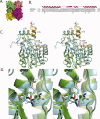The short-chain oxidoreductase Q9HYA2 from Pseudomonas aeruginosa PAO1 contains an atypical catalytic center
- PMID: 20340135
- PMCID: PMC2868251
- DOI: 10.1002/pro.384
The short-chain oxidoreductase Q9HYA2 from Pseudomonas aeruginosa PAO1 contains an atypical catalytic center
Abstract
The characteristic oxidation or reduction reaction mechanisms of short-chain oxidoreductase (SCOR) enzymes involve a highly conserved Asp-Ser-Tyr-Lys catalytic tetrad. The SCOR enzyme Q9HYA2 from the pathogenic bacterium Pseudomonas aeruginosa was recognized to possess an atypical catalytic tetrad composed of Lys118-Ser146-Thr159-Arg163. Orthologs of Q9HYA2 containing the unusual catalytic tetrad along with conserved substrate and cofactor recognition residues were identified in 27 additional species, the majority of which are bacterial pathogens. However, this atypical catalytic tetrad was not represented within the Protein Data Bank. The crystal structures of unligated and NADPH-complexed Q9HYA2 were determined at 2.3 A resolution. Structural alignment to a polyketide ketoreductase (KR), a typical SCOR, demonstrated that Q9HYA2's Lys118, Ser146, and Arg163 superimposed upon the KR's catalytic Asp114, Ser144, and Lys161, respectively. However, only the backbone of Q9HYA2's Thr159 overlapped KR's catalytic Tyr157. The Thr159 hydroxyl in apo Q9HYA2 is poorly positioned for participating in catalysis. In the Q9HYA2-NADPH complex, the Thr159 side chain was modeled in two alternate rotamers, one of which is positioned to interact with other members of the tetrad and the bound cofactor. A chloride ion is bound at the position normally occupied by the catalytic tyrosine hydroxyl. The putative active site of Q9HYA2 contains a chemical moiety at each catalytically important position of a typical SCOR enzyme. This is the first observation of a SCOR protein with this alternate catalytic center that includes threonine replacing the catalytic tyrosine and an ion replacing the hydroxyl moiety of the catalytic tyrosine.
Figures

References
-
- Tanaka N, Nonaka T, Nakamura KT, Hara A. SDR structure, mechanism of action, and substrate recognition. Curr Org Chem. 2001;5:89–111.
-
- Duax WL, Pletnev V, Addlagatta A, Bruenn J, Weeks CM. Rational proteomics. I. Fingerprint identification and cofactor specificity in the short-chain oxidoreductase (SCOR) enzyme family. Proteins. 2003;53:931–943. - PubMed
-
- Rossolini GM, Mantengoli E. Treatment and control of severe infections caused by multiresistant Pseudomonas aeruginosa. Clin Microbiol Infect. 2005;11(Suppl 4):17–32. - PubMed
-
- Boucher HW, Talbot GH, Bradley JS, Edwards JE, Gilbert D, Rice LB, Scheld M, Spellberg B, Bartlett J. Bad bugs, no drugs: no ESKAPE! An update from the Infectious Diseases Society of America. Clin Infect Dis. 2009;48:1–12. - PubMed
Publication types
MeSH terms
Substances
Grants and funding
LinkOut - more resources
Full Text Sources

